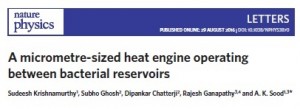 pdf
pdf
Be it in the first automobile ever manufactured – the Ford Model T – or a contemporary family sedan, the basic working principle of the heat engine has remained unchanged since it was first laid down by French Engineer Sadi Carnot in 1824. Heat from the exploding fuel-air mixture inside the engine is partly converted to work, the motion of the piston – and the rest is thrown out as waste heat to the outside colder environment. An essential prerequisite for such an engine to perform work is that in needs to operate between two thermal reservoirs a hot and a cold one. Unlike these familiar large engines, nanometer-sized molecular engines inside the human body, essential for transporting cargo within the cell and for moving our limbs, work at nearly 100% efficiency at a fixed temperature – the normal body temperature of 37.5°C stays put as we use our fingers to scroll through this write up. The functioning of these amazing machines has intrigued scientists for decades.
In a recent research breakthrough, a team of scientists from the Indian Institute of Science and the Jawaharlal Nehru Centre for Advanced Scientific Research in Bangalore suggest a potential physical mechanism that can enhance our understanding of how these molecular machines function. In a series of careful and high precision experiments, the Bangalore team studied the dynamics of an optically trapped colloidal particle, only 1/50th the thickness of the human hair, in a soup of motile bacteria. The bacterial mobility could be turned ON and OFF by very small changes in temperature. As opposed to large engines, micro and nanometersized engines are strongly perturbed by fluctuations in their environments. Thus, even while the temperature of the reservoirs was nearly constant, changes in the nature of fluctuations of the colloidal particle in the ON and OFF states of bacterial activity allowed these researchers to estimate the work done by the colloidal bead. Remarkably, this tiny artificial engine outperformed conventional engines in efficiency. These results were reported in the journal Nature Physics (DOI: 10.1038/nphys3870)
Reference: A Micrometer-sized Engine Operating Between Bacterial Reservoirs, Suddesh Krishnamurthy, Subho Ghosh, Dipankar Chatterji, Rajesh Ganapathy and A K Sood Nature Phys. 2016 (DOI:10.1038/nphys3870)


 pdf
pdf